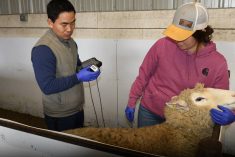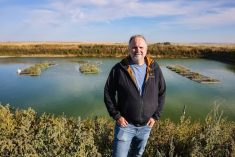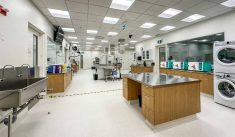Walking through the wetlands at Olds College is an education unto itself: Native plants and trees line every path that loops around 20 constructed ponds where waterfowl swim and songbirds flit from cattail to cattail.
But the wetlands are also home to something equally important — wetland research.
“Managing resources like water is critical,” said Ike Edeogu, Olds College’s Smart Agriculture applied research manager.
“As water is becoming more scarce, both from a quantity and quality perspective, it is becoming even more important to do this work.”
Read Also

Farming Smarter receives financial boost from Alberta government for potato research
Farming Smarter near Lethbridge got a boost to its research equipment, thanks to the Alberta government’s increase in funding for research associations.
In the past, the constructed wetlands have been used to investigate wastewater treatment, with sensors in each pond measuring water quality. But the bulk of the research today is located in the nearby greenhouse where preliminary work can be done in a controlled environment, said Edeogu.
One recent project looks at the use of native wetland species for phytoremediation — essentially, using plants to remove contaminants from the water.
“The intent is to look at treating feedlot run-off in these catch basins, but rather than doing chemical or engineering treatments, it’s primarily going to be focused on phytoremediation,” said Edeogu.
In the project’s first phase of the project, Olds College researchers added synthetic nutrients and then grew common wetland species on a series of floating islands in small tanks within the greenhouse.
“We used different native wetland species — things like cattails, water sedge, and others — to see how they performed in terms of removing nutrients and heavy metals like iron from the water,” he said.
Cattail, wheat sedge and water sedge were most effective at removing nutrients such as nitrogen, phosphorus, potassium, and sulphate while sweet flag and smartweed didn’t perform as well. They were then tested again, only this time the water came from the college’s feedlot catch basin.
Seven species (small-fruited bulrush, Baltic rush, wheat sedge, water sedge, cattail, mare’s tail, and smartweed) were able to remove phosphorus from the water, with removal rates between 77 and 84 per cent. They also reduced potassium levels by between 27 and 45 per cent (aside from smartweed, which had limited effects). Researchers also noted an increase in sulphate levels for most plant species, requiring further investigation.
“We have seen some plant species that are very effective at removing these nutrients from the water. I was pretty impressed,” said Edeogu.
Phase 3, which recently received $300,000 from Results Driven Agriculture Research, will get underway this year at three commercial feedlot operations.
“This next phase is actually in real-life working situations in commercial feedlots to see how well the selected plants work,” he said. “We’ve already done some preliminary sample analysis at the catch basins at the different feedlots to see what nutrients are in it, including nitrogen, phosphorus, and potassium.”
Fecal matter in the water will also be analyzed.
“With the run-off from the feedlots, we’re now expecting some parasites. So we want to see what’s in there,” said Edeogu.
One of the key concerns is blue-green algae, which is caused by excess nutrients like nitrogen and phosphorus in the water. Coupled with hot, sunny weather, this can result in cyanobacterial blooms that are toxic to cattle.
“We want to see what happens when we have these floating islands in there — will they also be able to negate or reduce the impacts of blue-green algae?” he said.
But the primary goal is to explore whether phytoremediation can help treat this water on site and remove enough of the contaminants that it becomes potable again — something that could save feedlot operators both time and money.
“One of the things we want to look at is the potential of improving water quality so that it can be reused as drinking water for the livestock,” said Edeogu. “If we can improve that, that would be huge. It would have a huge impact for agricultural production. This is very exciting for the agricultural sector.”















